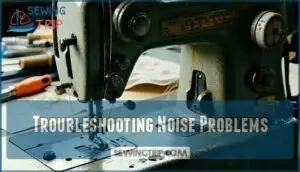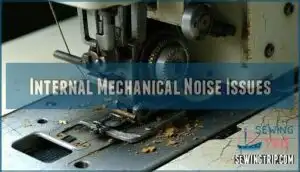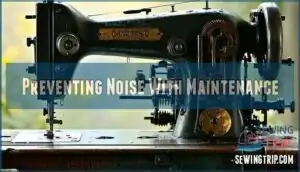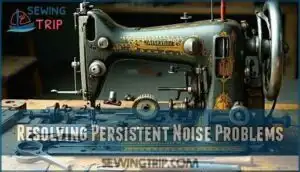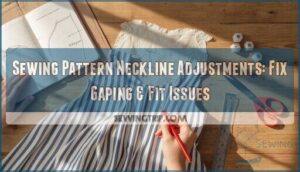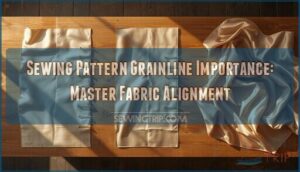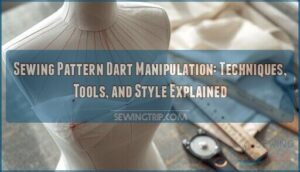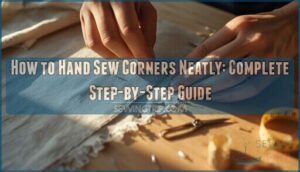This site is supported by our readers. We may earn a commission, at no cost to you, if you purchase through links.
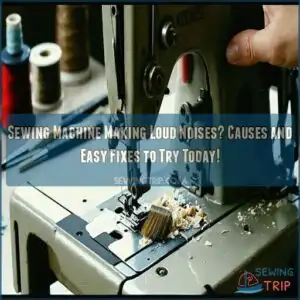 If your sewing machine is making loud noises, don’t panic—machines are like us; they get cranky if neglected.
If your sewing machine is making loud noises, don’t panic—machines are like us; they get cranky if neglected.
Start by checking for lint buildup in the bobbin area or feed dogs, as trapped debris often causes unusual sounds. Next, oil the machine per your manual’s instructions—dry parts can squeak and grind.
Look for loose screws, worn needles, or misaligned components, as these can add to the racket. Poor-quality thread or incorrect tension might also be the culprits.
Still noisy? The drive belt or gears could need attention. Keep calm—regular cleaning and quality materials often keep things running smoothly.
Table Of Contents
Key Takeaways
- You’ll often find that lint buildup in the bobbin area or feed dogs is the primary culprit for unusual sewing machine noises—regular cleaning after every project prevents these issues from developing.
- If your machine sounds louder than normal, don’t forget to check for loose screws and components, as these can create vibration and strange noises that’ll worsen over time if not addressed.
- You should always use high-quality thread and needles that match your fabric type, as poor-quality materials can create excess lint, cause tension problems, and ultimately lead to increased noise during operation.
- When basic troubleshooting doesn’t solve your noise issues, you’ll need to consider internal mechanical problems like timing issues, worn gears, or sensor malfunctions—don’t hesitate to seek professional service for an accurate diagnosis.
Sewing Machine Noise Causes
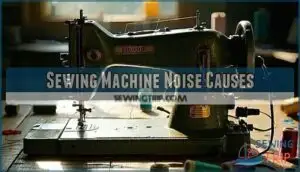
If your sewing machine is sounding louder than usual, it’s often a sign something isn’t quite right.
Common causes include issues with the needle, bobbins, or internal components that may need cleaning, adjustment, or professional attention.
Bernina Machine Noise Issues
Bernina sewing machine noise can be frustrating, especially when dealers dismiss concerns.
Dealing with persistent Bernina sewing machine noise can be exasperating, especially when dealer support falls short of expectations.
If your Bernina is noisy after minimal use, here are tips to troubleshoot:
- Clean and check the bobbin area for lint.
- Tighten loose screws.
- Replace needles showing wear.
- Record noises for warranty claims.
- Seek repair advice or compare with a demo model at another dealer to resolve the noisy issue and potentially make a warranty claim.
Thread Uptake Noise and Metallic Sounds
Metallic sounds during sewing could be due to thread uptake issues or lint hiding in tension discs, affecting uptake timing.
Start troubleshooting by inspecting the thread path and tension balance. Addressing unusual sounds may involve checking for issues with the front-loading oscillating hook system.
A quick guide to troubleshooting common problems is provided below:
| Problem | Likely Cause | Fix |
|---|---|---|
| Loud metallic noise | Lint in tension discs | Clean with a soft brush |
| Uneven uptake | Misthreaded path | Re-thread carefully |
| Clicking sound | Thread stuck in bobbin area | Remove debris with tweezers |
By following these steps and referring to the guide, you should be able to identify and fix common issues, such as a loud metallic noise or uneven uptake, and get back to sewing smoothly.
Thunking Sound With Every Stitch
A thunking sound with every stitch can make sewing a frustrating experience.
A rhythmic thunking with every stitch signals hidden issues—investigate promptly to restore smooth sewing and frustration-free creativity.
This rhythmic noise often hints at issues in the machine’s mechanics, like a loose hook driver or debris in the hook race.
Start with simple troubleshooting steps: clean the bobbin area, check for hidden threads, or tighten screws.
Persistent noisy sewing machine sounds may require professional sewing machine repair.
Noise Beginning After 10 Stitches
If your sewing machine grows noisy after about 10 stitches, it could signal underlying issues.
Though stitch quality might seem fine, the noise isn’t normal.
Troubleshoot before it escalates:
- Clean and oil the machine properly (even if it claims to be low-maintenance).
- Inspect the bobbin and hook for debris.
- Tighten loose screws carefully.
- Verify thread compatibility and tension.
Troubleshooting Noise Problems
When your sewing machine starts making loud or unusual noises, it’s a sign something needs attention.
By checking key areas like threading, screws, and lubrication, you can resolve many common noise problems and keep your machine running smoothly.
Cleaning and Oiling The Machine
Start with a quick cleaning to remove lint buildup—use a brush or vacuum attachment for hard-to-reach spots.
For oiling, refer to your manual’s recommended oil types and frequency. A common cause of noise can be lack of lubrication.
Avoid over-oiling; a tiny drop in the right spots is enough. Regular maintenance keeps your sewing machine quiet, preventing loud noises and ensuring smooth operation. Don’t skip this step, as it is crucial for preventing loud noises.
Checking for Loose Screws and Components
If your machine’s still loud, grab a screwdriver and identify screws in accessible areas.
Loose screws can cause vibration and strange noises. Follow a careful tightening sequence to make certain all are snug—don’t over-tighten!
Different screw types might need specific tools, so check your manual.
Regular sewing machine maintenance, like this, keeps things humming instead of clanging, and it is a part of regular maintenance that can prevent issues, and doing it carefully is important.
Verifying Thread Quality and Compatibility
Sometimes sewing machine noise comes down to thread quality and compatibility. Poor thread material or mismatched thread weight can affect machine tension, leading to loud noises.
Double-check your needle size matches the fabric type and thread. Low-quality thread frays, creating lint buildup.
Investing in good thread prevents unwanted interruptions and helps keep sewing machine troubleshooting simpler and less frustrating. Using quality sewing threads can substantially improve your sewing experience with the right thread material and compatible threads.
Inspecting Drive Belt Tension
Checking drive belt tension is essential for sewing machine noise solutions.
Start with a visual inspection to spot cracks or wear in the belt material.
If tension feels too tight or loose, consider a tension adjustment.
Remember, replacement timing matters—an old belt causes sewing machine loud issues.
For stubborn fixes, professional checkups are essential in sewing machine troubleshooting and repairs.
Internal Mechanical Noise Issues
If your sewing machine is still noisy after basic troubleshooting, internal mechanical issues could be the culprit.
Problems like a cracked O-ring, timing misalignment, or worn gears may require a professional technician’s expertise to fix.
Potential Cracked or Broken O-Ring
If your sewing machine’s loud noises persist, a cracked or broken O-ring might be the culprit.
Inspecting O-rings is key—damaged ones can disrupt smooth operation, causing knocking sounds.
Over time, poor O-ring materials or improper storage lead to wear, and follow your warranty coverage for replacement to avoid extra costs.
This quick sewing machine repair tip restores peace and precision, and helps to maintain your machine’s optimal performance.
Timing Issues and Internal Gear Problems
When your sewing machine starts grinding or knocking, it may point to a timing issue or internal gear problem.
Misaligned gears or worn components could disrupt smooth operation.
Timing adjustment and proper gear lubrication often help, but deeper issues might require professional diagnosis.
Ignoring these signs risks worsening damage, so don’t delay in addressing potential internal gear wear to prevent further problems, and ensure you get a professional diagnosis if needed.
Sensor Malfunctions and Professional Service
Sensors can cause a racket when misaligned or malfunctioning, often requiring diagnostic equipment and technician training to fix.
Ignoring these sewing machine problems can worsen loud noises.
- Sensor Calibration: Professional service guarantees proper alignment and smooth performance.
- Repair Guarantees: Certified technicians back repairs with warranties.
- Service Costs: Early fixes prevent pricier repairs and extend your machine’s lifespan.
Certified Technician Inspection and Repair
When sewing machine noise troubleshooting feels beyond reach, it’s time for a certified technician. Their qualifications guarantee precise diagnostics using advanced equipment.
Repair costs vary, but part availability and service guarantees often streamline repairs. Professional service identifies hidden issues like timing errors or worn gears.
Many technicians also provide nationwide service coverage for convenience. Trust technician service for accurate sewing machine repairs and peace of mind.
Preventing Noise With Maintenance
You can keep your sewing machine running quietly by sticking to a consistent maintenance routine.
Regular cleaning, oiling, and replacing worn parts will prevent many common noise issues and protect your machine’s performance.
Regular Cleaning and Oiling Schedule
Keeping your sewing machine quiet starts with regular cleaning and oiling. Stick to your manual’s maintenance schedule.
Follow these steps:
- Clean lint with a brush after every project.
- Oil key lubrication points monthly (avoid over-oiling).
- Use high-quality sewing machine oil.
Proper maintenance requires using specialized machine lubricants. Wipe with a soft cloth to prevent build-up.
Don’t skip scheduled sewing machine maintenance tips, as this is crucial for the longevity and performance of your machine, ensuring it remains in good working order with regular oil checks.
Inspecting Bobbin and Hook Areas
Noise often starts in the bobbin area. Check for lint, threads, or Hook Race Debris lurking unnoticed.
If you’ve got Drop-in Bobbins, inspect for bumps or damage—Smoothing Bumps with fine sandpaper can help.
A bent spring in the Bobbin Case might need replacement. These small steps keep your sewing machine’s hook mechanism running smoothly and prevent frustrating sewing machine noise causes.
Replacing Worn or Damaged Parts
When fixing noisy machines, replacing worn or damaged parts can work wonders.
Here’s what to check:
- Inspect the O-ring for cracks; replace if needed.
- Examine the hook driver for looseness or wear.
- Swap out a dull or bent needle promptly.
Regularly replacing needles guarantees optimal stitching performance.
Replace worn bobbin cases to avoid vibration.
Address internal gear failure with a technician’s help, as this requires specialized knowledge and tools to fix properly.
Using High-Quality Needles and Thread
After replacing worn parts, focus on high-quality needles and threads. The right needle type and thread composition improve stitch quality and reduce noise.
For compatibility, match thread and needle to fabric. Needle replacement removes burrs causing noise. To guarantee superior performance, consider needle thread pairing.
Check this quick guide:
| Issue | Cause | Needle Solution | Thread Suggestion | Benefit |
|---|---|---|---|---|
| Clicking noise | Burr on needle | Replace with new needle | Use polyester thread | Smoother stitching |
| Uneven stitches | Wrong needle size | Select correct size | Cotton for natural fabric | Better tension |
| Fraying thread | Rough needle eye | Change needle entirely | Silk on delicate fabric | Reduced fraying |
| Skipped stitches | Dull needle | Use sharp needle | Nylon for stretch fabric | Consistent results |
| Loud operation | Incorrect pairing | Guarantee fabric compatibility | Balanced thread/needle | Noise reduction |
By following these guidelines, you can ensure better tension, smoother stitching, and reduced fraying, ultimately leading to a more consistent and quiet operation.
Resolving Persistent Noise Problems
If your sewing machine’s noise just won’t go away, it’s time to examine a few precise steps to address the issue.
Comparing your machine’s sounds to a demo model or consulting a professional can help pinpoint problems and get things running smoothly again.
Consulting Another Dealer or Bernina Corporate
If your dealer isn’t helpful, consider switching to another Bernina dealer for a second opinion.
Warranty disputes? Contact Bernina corporate directly for support. They might resolve service alternatives swiftly.
Always bring detailed notes or even a video highlighting your sewing machine’s noise issues. A proactive approach guarantees your Bernina’s warranty and service needs are met without frustration.
Comparing Machine Noise to Demo Model
If your sewing machine’s noise feels off, comparing it to a dealer’s demo model is a good idea.
This Sound Level Analysis can easily highlight Noise Discrepancies Explained.
Follow these steps:
- Test the demo model for acceptable noise thresholds.
- Note differences like sewing machine clicking, knocking, or grinding.
- Share findings with the dealer for further guidance.
Seeking Professional Service for Accurate Diagnosis
If the noise persists, it’s probably time to enlist a sewing machine technician.
Certified service technicians have the diagnostic equipment to pinpoint hidden issues.
A professional diagnosis guarantees accuracy, whether it’s a timing issue or worn parts.
Regular maintenance can prevent dirty or clogged mechanisms from causing persistent noise.
Repair shops often provide service guarantees, so ask about expected repair costs upfront.
Some even offer remote diagnostics, saving you a trip!
Frequently Asked Questions (FAQs)
Why is my sewing machine making loud noises?
Your sewing machine’s loud noises could stem from debris in the bobbin area, improper lubrication, or worn parts like the needle or hook race.
Check and clean these areas thoroughly, and oil if necessary, to address issues like improper lubrication.
Why is my sewing machine making a screeching noise?
A screeching noise often means lack of lubrication or debris buildup.
Check for lint or thread jams, clean the bobbin area, and oil moving parts.
If it persists, a worn belt or bearings might need service.
What is the problem if sewing machine runs noisy?
Think of your machine as a symphony out of tune—noisy operation often hints at lack of oil, debris buildup, or loose parts.
Clean, oil, check the needle, and inspect the bobbin for hidden issues.
How do I know if my sewing machine motor is bad?
If your sewing machine struggles to turn, heats up unusually, or emits a burning smell, the motor might be failing.
Check power connections, and if issues persist, a professional inspection is essential.
What are common causes of needle plate rattling?
Did you know that 40% of rattling issues come from loose screws?
Check your needle plate screws first.
Also, inspect for debris, misaligned parts, or uneven surfaces that might amplify vibrations during operation.
Could warped fabric contribute to machine noise?
Warped fabric can mess with your sewing rhythm, especially if it catches or drags unevenly.
This resistance might create extra tension or vibrations, amplifying machine noise.
Always check fabric alignment before starting to avoid issues with your sewing rhythm.
How does sewing speed impact machine noise levels?
Like a car engine revving too high, faster sewing speeds can amplify machine noise by stressing internal components.
Slower speeds reduce vibration and wear, helping your machine run smoother, quieter, and for longer.
Are noise issues affected by climate or humidity?
Climate and humidity can impact noise levels in your sewing machine.
High humidity or sudden temperature changes may cause materials like gears and plastic to swell or contract, leading to tighter friction, vibrations, or louder operation, as they can lead to vibrations.
Can misaligned presser feet cause unusual noise?
Did you know 80% of sewing machine issues stem from overlooked details?
Misaligned presser feet can cause odd noises as they hit the feed dogs or fabric unevenly.
Always make certain of proper alignment to avoid unnecessary clatter and ensure that the machine operates smoothly, which is a key point to remember for proper maintenance.
Conclusion
Remember, "an ounce of prevention is worth a pound of cure" when dealing with a sewing machine making loud noises.
By following these troubleshooting steps and maintaining a regular cleaning schedule, you’ll extend your machine’s life and keep your sewing sessions peaceful.
Don’t hesitate to seek professional help if the noise persists—sometimes expert hands are needed, and with proper care, your trusty sewing companion will hum along quietly for years to come, making it a valuable sewing companion.
- https://www.quiltingboard.com/main-f1/sewing-machine-making-bad-sound-while-sewing-t284056.html
- https://sewingbecomeasy.com/why-is-my-singer-sewing-machine-squeaking/
- https://leatherworker.net/forum/topic/107853-class-26-loose-stitchesloud-noise/
- http://shesasewingmachinemechanic.blogspot.com/p/what-to-check.html
- https://www.quora.com/What-causes-the-sewing-machine-to-produce-a-mess-of-threads-on-the-underside-of-the-material-being-sewn

